1956 French Grand Prix race report: Collins takes second win in a row
Collins takes advantage of Fangio misfortune and outfoxes Castellotti to take a second victory
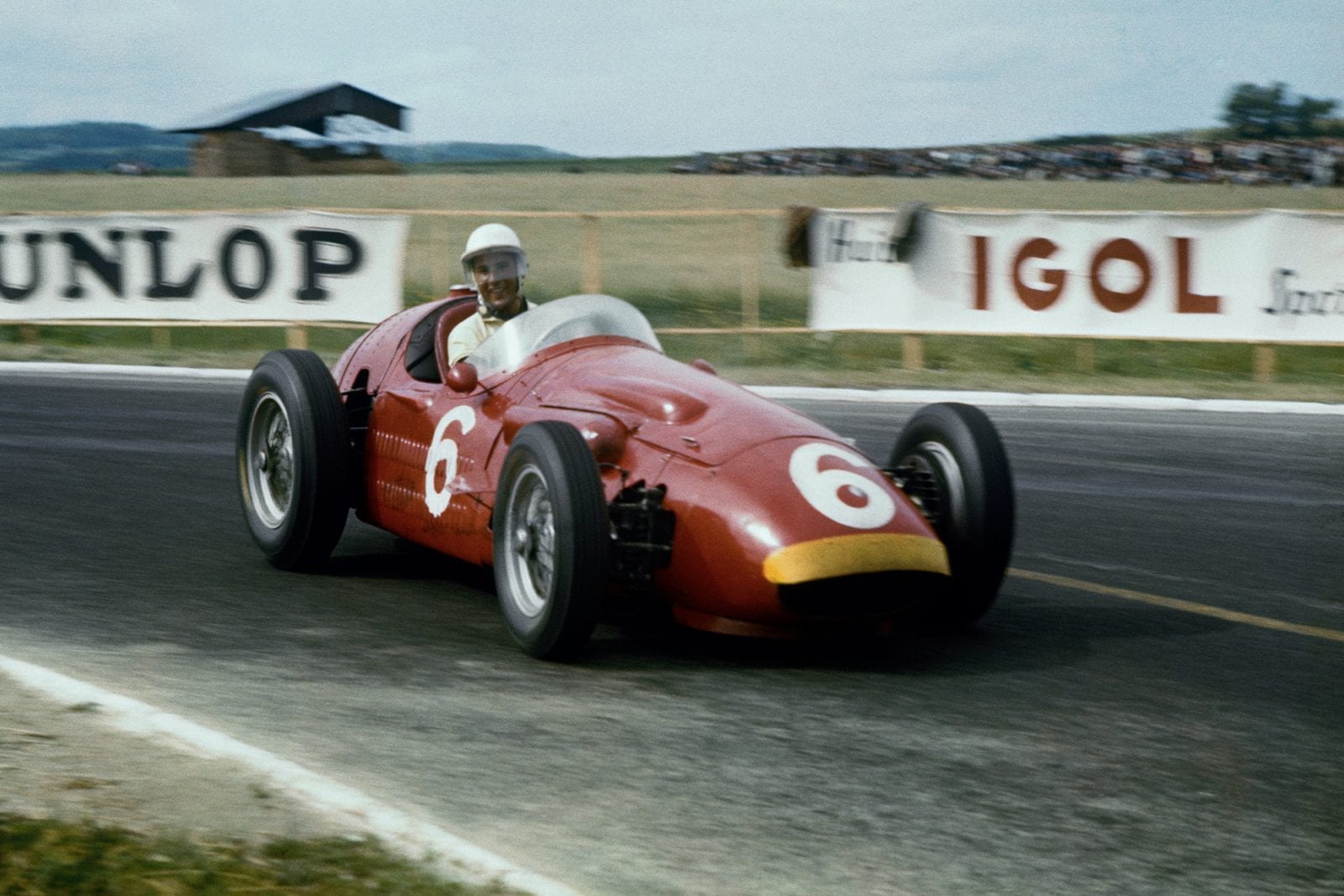
Motorsport Images
The triangular circuit of Reims-Gueux is one of the few that have not been altered over the past year or two, and remaining the same as when last used in 1954 (for it will be remembered that the 1955 event was cancelled), the performances recorded during this 42nd French Grand Prix could bear direct relationship to the 1954 event.
Qualifying
During the 1954 practice Fangio made history with a W196 Mercedes-Benz by being the only driver to average more than 200kph for one lap. He did this by a matter of a few decimal points and only once, so clearly a 200kph lap was going to be the aim of all the competitors in this 1956 event. On the first evening the complete Vanwall team were out and Ferrari had five Lancia/Ferraris in the paddock, while there was no sign as yet of any Maseratis.
As the BRM team had not entered Hawthorn was loaned to the Vanwall team, and with Trintignant due to drive the new Bugatti 251 his place was taken by Colin Chapman, making his first serious entry in Grand Prix racing, the third Vanwall was naturally in the hands of Schell. The advances that have been made in Grand Prix cars since the beginning of the current Formula was shown when Schell got the Vanwall round in 2min 29.5sec, a speed of 199.908kph, and almost immediately afterwards Hawthorn did 2min 29.0sec, which gave him 200.579kph.
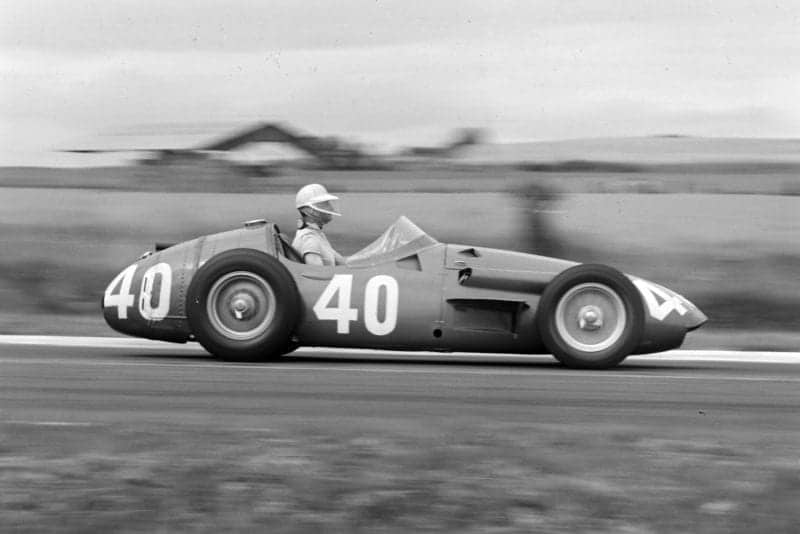
Godia started a lowly 17th
Motorsport Images
There was no question of doubt that the Vanwalls were really motoring, and during the evening both drivers improved on their times. Chapman was feeling his way along carefully and at the same time breaking-in a new engine. In the Ferrari pit there was a slight gloom, for the only regular team man out for this first practice was Collins, he being accompanied by de Portago and Gendebien, and as they were both new to the V8 Grand Prix cars the honour of the Scuderia was resting with the British driver. The Vanwalls were really setting the pace and Hawthorn reduced his times steadily until he reached 2min 27.0 sec, 203.308 kph.
Of the five Lancia/Ferraris in the paddock, one was fitted with an all-enveloping nose-piece and “mudguards” over the rear wheels which attached to the main body structure and formed a completely enclosed rear end. However, this car was not used during the first practice period, and Collins was trying three of the normal cars, one of which had the front anti-roll bar uncoupled, but which proved to be horrible on the fast bend after the pits.
“When it was beginning to look as though the Vanwall team had got the better of Ferraris, Collins went out again and suddenly produced a 2 min 27.6 sec lap”
When it was beginning to look as though the Vanwall team had got the better of Ferraris, Collins went out again and suddenly produced a 2 min 27.6 sec lap and then his pit signalled him to use all he had got and, by letting the V8 engine go to 8,900 rpm, he turned a lap in 2 min 25.6 sec, at the incredible speed of 205.263 kph (127 mph). Schell went out again to attempt to retrieve the honour of Vanwall, but failed, though he made second fastest time in 2min 26.8 sec (using Chapman’s car) without stretching the Vanwall at all, whereas the Lancia/Ferrari was over the limit.
The next day saw much more activity, and as Fangio and Moss were out everyone stood back to see how they could improve on the times of Collins. As Musso was still convalescing after his Nurburgring accident, the Scuderia Ferrari team was Fangio, Castellotti, Collins, de Portago and Gendebien, and Castellotti was the first to try the “streamlined” car. The Scuderia Maserati were hardly recovered from their Supercortemaggiore chaos and had one car for Moss, Behra (fit once more after a slight operation), Taruffi and Perdisa to use, this being the long-nosed high-sided Spa car with fuel-injection engine, and the factory mechanics were also looking after the private cars of Godia and Piotti, the latter’s car being driven by Villoresi.
All three Vanwalls were out once more, but before they started going fast an unfortunate accident eliminated two of them. Hawthorn was on a “warming-up” lap and approaching Thillois hairpin at touring speed, while Chapman was rushing down the hill behind him. Approaching the hairpin, the second driver had a front brake lock solid and, unable to stop, he rammed the tail of the leading Vanwall; Hawthorn was pushed straight on up the escape road and Chapman slid off the road and hit a concrete pylon, with a result that both Vanwalls were damaged, though fortunately neither driver was hurt.
Trintignant was out with the new Bugatti, in fact with two Bugattis, for they brought along the prototype car as well as the new one with slightly longer wheel-base and neater bodywork. Neither of them was very fast, the new one spending most of the period being run-in, as it was brand new. Even so, with a lap time around 2min 40sec, they did not look very happy on the fast bend after the pits. The “streamlined” Lancia/Ferrari was little better and Castellotti soon gave it back, for there was a cross wind on the very fast pits-bend and the car snaked about horribly. Later it was tried without the tail fairing, which improved the handling, but then it was no faster than the normal car, once again showing that streamlining is not just a question of getting the “panel-basher” to work.
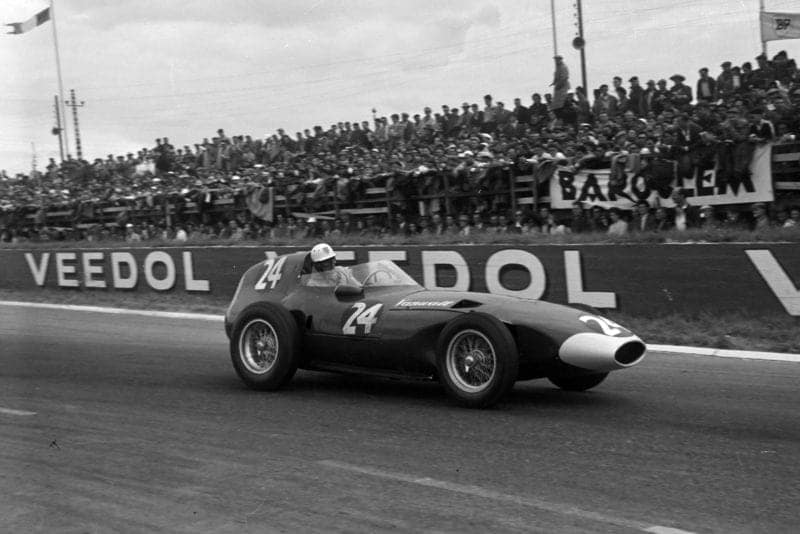
Hawthorn qualified 6th on the grid
Motorsport Images
As expected, Fangio went straight off into a hot pace, starting with 2min 26sec, and finishing with 2min 25.2sec. Nobody else approached this time, Collins being content with a few relatively slow laps in 2 min 30 sec, while the Maserati team were very unhappy, Moss and Behra being unable to get below 2min 34.4sec, the factory Maserati being slow, having the wrong ratios in the gearbox and erratic brakes.
“Fangio was taking one of the world’s fastest Grand Prix cars round without easing the throttle”
Schell was doing his best, and improved on his previous time with a lap in 2 min 26.1 sec, and then Fangio went out again, and a time of 2 min 24.8 sec showed that he was now trying. As he went past the pits at nearly 160 mph everyone listened for him to lift his foot off the accelerator as he approached the long right-hand curve; the scream of the eight megaphones remained constant until it died away in the distance, and everyone, drivers included, paid tribute to the World Champion.
Good drivers on slower cars were lifting off on this blind right-hand curve, and Fangio was taking one of the world’s fastest Grand Prix cars round without easing the throttle. The only other driver to do this was Moss with the Maserati, but he was travelling somewhat slower. This performance by Fangio was impressive enough, but his time was more so, for he recorded 2 min 23.3 sec-208.557 kph, and before practice began it was wondered whether anyone could beat 200 kph. When he returned to the pits this full-bore through the curve became even more impressive, for he quietly explained that the gear-lever was jumping out of fifth and halfway round the curve he had to let go of the steering wheel with his right hand and hold the lever in gear! World Champion?
Of the others, de Portago was getting the hang of a powerful Grand Prix car and got down to 2 min 30.9 sec, while Gendebien was being very careful and still at 2min 35.6sec. Gordini had two eight-cylinder cars running, da Silva Ramos being fastest with 2min 41.1sec. Castellotti was looking down his nose, for he could not approach the times of Fangio and Collins, or even Schell, while the Maserati drivers were prepared to go home and forget Grand Prix racing, so hopeless was the factory car.
The third and last practice period saw the Ferrari team taking things comparatively quietly, merely checking that gear ratios and tyre sizes were right, and taking readings on tyre wear and fuel consumption. As a half-hearted experiment (or leg-pull) all five cars were fitted with extensions to the radiator cowling that were exact copies of the Vanwall nose.
Maserati were out in full force, with an air of desperation about them, having two injection cars, the Spa model with high cockpit sides and last year’s all-embracing “streamlined” car, this one also being fitted with Dunlop disc brakes especially for Moss. In addition there were three normal factory cars and the private ones of Godia and Villoresi, while not far away were the two blue ones of Rosier and Simon.
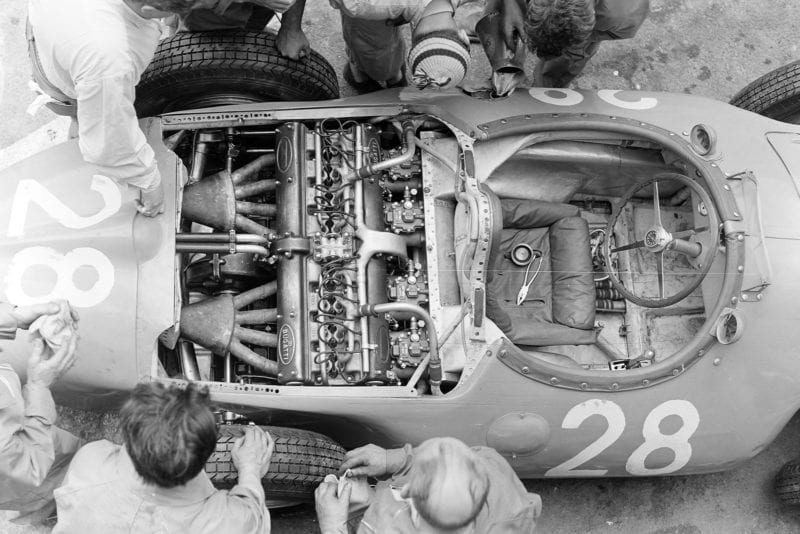
Trintignant’s Bugatti in the pits
Motorsport Images
Gordini had added a six-cylinder car to his team, the driver being Pilette, while da Silva Ramos and Manzon were still on the eight-cylinder cars. The Vanwall mechanics had done some overtime and repaired Hawthorn’s car by using bits off the undamaged rear end of Chapman’s car, so they were able to run two cars, Hawthorn’s and Schell’s. Since the previous day the wind had changed slightly and was now blowing down past the pits towards the Thillois corner and as a result times were a bit slower, though much to his joy Castellotti was fastest of the evening with 2min 24.6sec, so that a Lancia/Ferrari was fastest each day, and each time with a different driver, Collins, Fangio and Castellotti thus reserving the front row of the starting grid.
Behra eventually managed to scratch a rather mediocre 2min 27.8sec, which was not as fast as Hawthorn’s Vanwall, but which beat the best Moss could do on an inferior car. The “streamlined” disc-brake Maserati was barely used before it was discarded as useless and the injection engines were still not satisfactory. The Bugatti was out again, but disappointingly slow and Gordini was very happy, for his eight-cylinder cars were now much faster. Rosier was in fine form and without hurrying was faster than lots of younger drivers, including Perdisa and all the Gordinis. while Villoresi was even faster.
Saturday was a complete day of rest for the drivers, while the mechanics had plenty of time to prepare the cars for the actual race, and Sunday afternoon saw the track dry, but the sky overcast, as the cars were lined up on the grid for the start. The front row contained three Lancia/Ferraris in the order Fangio, Castellotti and Collins, all the cars having normal nose cowlings, all the streamlining having been discarded.
Behind these three was an encouraging sight for the many British spectators present, for the next three fastest practice times were made by Vanwalls, in the order Schell, Chapman and Hawthorn. Actually, Chapman’s time had been made by Schell using his starting number, he not getting below 2 min 36 sec, but nevertheless it was three different Vanwall cars that had recorded the times. Chapman being a non-starter, Schell was alone in the second row, and behind him were Hawthorn, Behra and Moss.
Then came de Portago and Villoresi, followed by Gendebien, Rosier, and Taruffi, the two eight-cylinder Gordinis in row 6, Perdisa, Godia and Trintignant in row 7, and Pilette and Simon at the back. Hawthorn’s car had been fitted with the engine from the crashed Vanwall, it being considered a better one. Moss had the Spa Maserati with a carburetter engine, and Perdisa a normal model fitted with an injection engine, he and Taruffi changing cars at the last moment. Trintignant was using the short-chassis prototype Bugatti, with the engine from the new car, and thus everyone was ready for the 42nd French Grand Prix, with its fabulous first prize of £10,000 offered by the BP fuel company.
Race
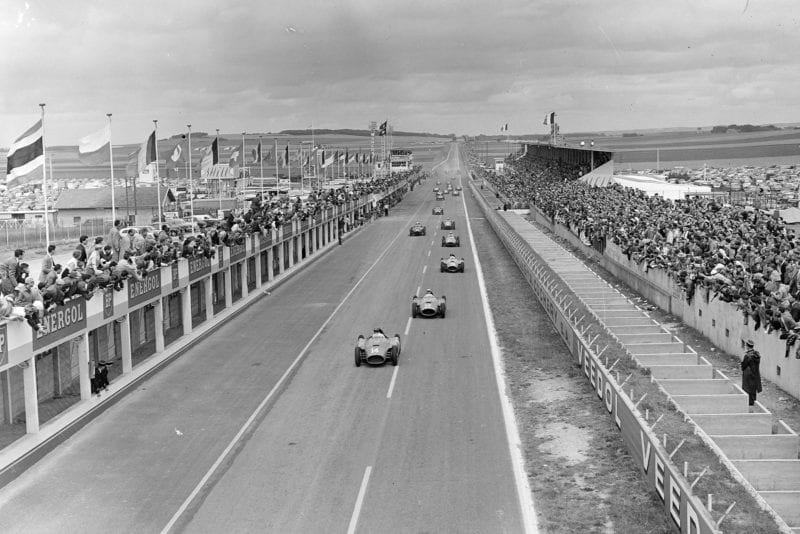
Peter Collins leads at the start
Motorsport Images
As the flag was raised a rain-shower fell on the cars and mechanics were still trying to get the electric starter into the front of the Moss car, and with 30 seconds to go they flung the starter away and began to push. It still would not start, so Moss let them push him past Fangio and up the road in front of the grid, which prevented Charles Faroux dropping the flag until the Maserati engine was running and the car back in its position on the grid. Villoresi, on the other hand, was being pushed back and forth on his grid position trying to get his engine to start, and when the flag fell he still had not got it started. Away they went, the 18 cars disappearing under the Dunlop Bridge in a howling pack, while Villoresi in the 19th car was eventually started and joined in later.
As they screamed down the hill towards Thillois the three Lancia/Ferraris were out on their own, followed by Schell, Moss, Hawthorn and Behra and at the end of the opening lap it was Castellotti, Fangio, and Collins in a tight bunch. On the second lap Schell broke second gear and wasted time sorting the gearbox out, so that he dropped to ninth position, letting Hawthorn into fourth place, but already the Castellotti-Fangio-Collins trio were out on their own.
Fangio was the first to set a new official lap record, with 2min 29.8sec, though the three of them were nose to tail and often side by side. Simon and Taruffi made visits to the pits in these opening laps, and the Bugatti was the first French car, though a long way back. After five laps the leading trio were five seconds ahead of Hawthorn in fourth place, who was followed by de Portago, Behra, Gendebien, Moss, Schell and Perdisa, the rest already being way behind. Schell came into the pits with a damaged engine having over-revved in bottom, and Perdisa went by with smoke coming from the bonnet, due to an oil leak dripping on to the exhaust manifold.
Fangio took the lead, and in team order the three Scuderia Ferrari cars looked all set to give a demonstration run. Schell did one more lap and then retired with water in the wrong places from an internal injury in the engine, and all British horses rested on Hawthorn, but though he was fourth, he was losing ground. The Bugatti was engaged in a wheel-to-wheel battle with Manzon’s eight-cylinder Gordini, though da Silva Ramos had outpaced both of thern and gone ahead and in front a all three, Rosier and Godia were having a very gentlemanly scrap.
By 10 laps the first three had lapped Pilette’s old Gordini, and were 13 seconds ahead of Hawthorn, who in turn was comfortably ahead of de Portago and Gendebien, followed by Behra, Moss in a very unhappy situation, Perdisa, the Godia/Rosier battle, da Silva Ramos, and Trintignant having got the better of Manzon. On the next lap Hawthorn was flagged into the pit and handed the lone Vanwall over to Schell, for the British driver had not long before been driving in the 12-hour sports-car race for the Jaguar team and was getting tired.
This let de Portago and Gendebien by, as well as Behra and Moss, so that the Lancia/Ferraris were now 1, 2, 3, 4, 5 and all sounding perfect. One lap later Moss retired at the pits with a broken gear-lever and then Perdisa was flagged in to hand over to his team leader, a thing that is becoming a regular habit. The cockpit of this second Maserati was swilling in oil, and while Moss did some mopping up with a piece of rag, the fuel tank was filled, as the consumption of the injection engine was still not good enough. As Moss rejoined the race in the borrowed car the leading trio went by in close formation, so that even with a perfect car he could hardly hope to make up a whole lap.
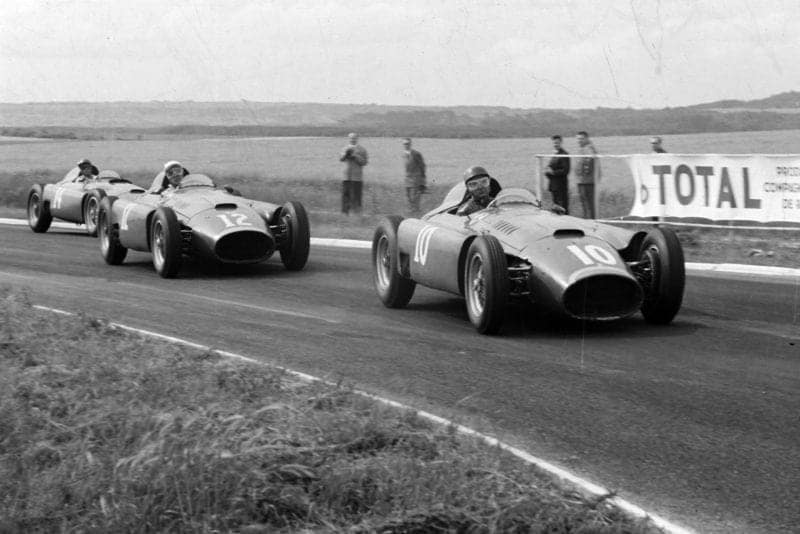
Castellotti leads Fangio and Collins
Motorsport Images
Schell was-now driving Hawthorn’s Vanwall with a very determined air and on lap 14 he was 42 sec behind the leader. First of all he dealt with Behra, which got him into sixth place, and then he closed up on Gendebien, all the while the gap between the British car and the leading Lancia/Ferrari was being reduced. The Bugatti stopped at the pits with jammed throttles (due to the dust collected by the air-intake system), and had to retire, while Moss was steadily losing ground to the triumphant Prancing Horse trio.
At 20 laps Schell was 28 seconds behind them, and passed Gendebien with ease, and at the same time de Portago retired with a broken gearbox. This put Schell into fourth place, but the Ferrari pit thought he was a lap behind the leading trio instead of a mere 28 seconds, they not having noticed that he had taken over Hawthorn’s car. As a result, they did not give their drivers any warning of the approaching Vanwall, and even when Schell whistled past Moss they did not worry.
This terrific progress of the green car had the crowd on its feet and with a new lap record in 2 min 29.4 sec (200.042 kph), Schell was only 12 seconds behind the Lancia/Ferraris. Each lap he got closer and the crowd cheered louder, and the Ferrari pit began to wonder if something was wrong and by lap 28 he was right behind Collins, and in a panic Ferraris realised their mistake and gave their triumphant trio the “press-on” signal. This they did, but they could not shake the Vanwall off, for Schell had really got the bit between his teeth and he was determined to break up the red cars. Time and again he tried to get past, but for once the mixed Ferrari team of Argentine.
Italian and British drivers had to work as a team, and they deliberately drove along the straights side by side to keep the green car from going by, for without any doubt it was noticeably faster on maximum speed. On lap 31 the four cars approached the Thillois hairpin in a bunch and Schell forced his way through on the inside, displacing-Collins and Castellotti in one fell scoop, so that he came past the pits right in Fangio’s slipstream, while the crowds stood up and cheered.
“Schell forced his way through on the inside, displacing-Collins and Castellotti in one fell scoop, so that he came past the pits right in Fangio’s slipstream, while the crowds stood up and cheered”
Now the old man really had to try and he shook the Vanwall off round the long fast curve and through the bends to Muizon, but the other two Italian cars were still behind. On lap 33 Fangio pulled out 2 min 25.9 sec, and Schell was elbowed into third place at the Thillois hairpin, but still the gallant Franco-American would not give up and was back in second place at the end of the lap.
The new record lap by Fangio got him away on his own by a few lengths, and then Collins and Castellotti both forced their way by the Vanwall, and calling a truce for once they got together and fixed the British car well and truly. As the four cars came up the finishing straight. Fangio was still some lengths ahead and the other two were side by side, with Schell desperately trying to get by with his faster car.
There was no doubt now, that the Ferrari team were not going to be disturbed any more, for Fangio went by with a full-throttle scream from his megaphones, and the other two went by with a slightly different note as they eased the throttles minutely, to drop perhaps 1 or 2 mph off their speed. Poor Schell was unable to get by, as they were still side by side, and so Fangio was able to draw well away into the lead.
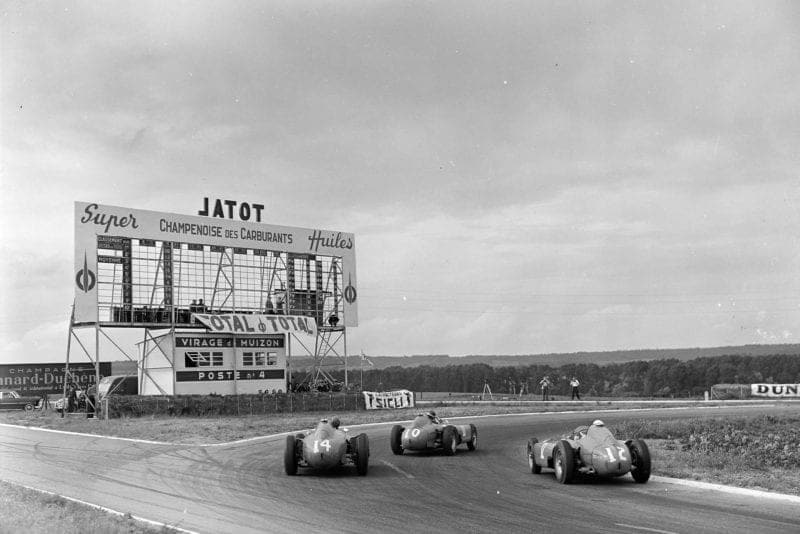
The Ferraris battle on
Motorsport Images
The wonderful if desperate effort, by the lone British car was over, and Schell then began to ease off and sit back in fourth place, but he was content in the knowledge that he had made the Scuderia Ferrari pull out all the stops and scrape the bottom of the bag for some team tactics to deal with the Vanwall.
This excitement carried the race through to the 37th lap and the next time round the Vanwall stopped at its pit. After this valiant effort a ball-joint in the linkage to the injection pump had sheared off, and although another one was fitted it was impossible to get the adjustment right in the time available, so Schell had to rejoin the race running on a weak mixture. Gendebien stopped on the same lap and retired with no clutch, and the situation was now Fangio, Castellotti, Collins, Behra and Moss, the last-named over a lap behind the leaders.
As the three Maranello cars started their 40th lap they were given the slow signal, for all danger had now passed, but next time round there was consternation for Fangio drew into his pit. A fuel line had split and in no time mechanics were making a repair with rubber tubing and wire. But before he could rejoin the race Behra had gone by and Castellotti and Collins were approaching from Thillois, Yet again a certain victory for Fangio was taken from his grasp for he could not hope to make up nearly a whole lap.
Barring any further untoward incidents the race was now run and it just remained to be seen which of the leading pair was going to settle into to the lead. Castellotti led until the end of lap 46, then Collins led for two laps, then Castellotti once more, and on lap 50 Collins went back into the lead, where he stayed until the total of 61 laps had been completed. The Ferrari pit was not letting its drivers know how many more laps they had to complete so that neither driver should know exactly when he would reach the 50th lap, at which the “Stay as you are” signal would be given. However, Collins had some friends in other pits keeping him informed so that he made sure he was in the lead at the right time and was thus able to tour home the winner.
“Collins had some friends in other pits keeping him informed so that he made sure he was in the lead at the right time”
Behra was running very regularly in third place, 70 seconds behind the leaders, but in fourth place Fangio was piling on all he had in an attempt to catch Behra. Some laps behind the leaders was Schell, whose Vanwall was gradually burning out its valves due to the weak mixture and getting slower and slower, being overtaken first by Rosier and then by Godia, while right at the back were the three Gordinis, in the order Silva Ramos. Manzon and Pilette.
Having no hope of catching anyone, or being caught, Moss made a brief stop for more oil, as most of the tankful was in the cockpit, and in complete command of the race the two Lancia/Ferraris of Collins and Castellotti were flagged home. Behra arrived in third place, but only five seconds behind thundered Fangio, never relaxing for a moment and his 61st and last lap was a new record in 2min 25.8sec, another example of his tenacity and fight against ill-fortune, just as he had demonstrated at Monte Carlo. Of the 19 starters, only four finished on the same lap, the other seven finishers being laps behind.
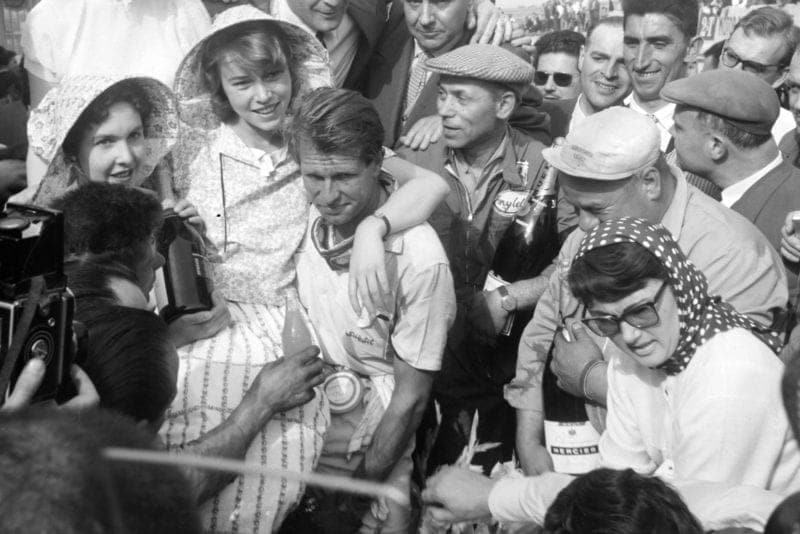
Collins soaks up the crowd’s adulation
Motorsport Images
Reims remarks
- Although the Ferrari team were told to keep their Lancia engines down to 8,200 rpm on the straights they were soon racing against each other and going to 8.500 rpm and more.
- Villoresi ran out of brakes approaching Thillois hairpin and went down the escape road, the marshals drawing back the sun-curtain to let him go through.
- The Vanwalls were estimated to be doing 285 kph down the hill to Thillois, approximately 177 mph. Since Spa, their handling on fast corners has been greatly improved by the sort of development progress that can only bring success.
- After the race Mr Vandervell was a bit incensed by the way the Ferrari drivers “ganged up” on Schell. It will not be long before we shall see a Vanwall team dealing with a Ferrari in the same way.
- Of the broken throttle control on the Vanwall, the less said the better, but it really is time a representative from an aircraft factory paid a visit to Acton. The Goodyear disc brakes actually gave trouble in practice!
- The works Maseratis have as much power as their rivals, but a poor torque curve; some people live and learn, others just live.
- The finish on the Bugatti 251 was such that members of the BOC turned away and wept, but at least the badge remains the same.
- Something must have happened at the Gordini factory, three cars started, and three cars finished.
- It is becoming difficult to remember the first Grand Prix win by a British driver, now it will be a memorable occasion when a British driver does not win. Hurrah, hurrah. Next step is for them to drive British cars and for the industry to take note. Collins was well in the lead for the World Championship after this event, but Behra keeps plugging along with regular placings.
Notes on the cars at Reims
Vanwall
The three Vanwall cars were virtually identical, all being 1956 models and unchanged since previous appearances. The car that Chapman crashed was the latest one to be built and like the No 2 was fitted with an elektron body. Without any doubt these cars were the fastest on the circuit from the point of view of maximum speed.
Ferrari
The five Ferrari-entered Lancia V8s were of the latest modified type, with tail tanks and small tanks on each side of the cockpit and the bodywork faired into the empty pontoons between the wheels, as introduced at Syracuse. All were using four grouped megaphone exhaust pipes on each side and were running on Solex double-choke downdraught racing carburetters, One car was brand new, having a chassis frame built by Ferrari, as distinct from the actual Lancia built cars modified by Ferrari. This meant that the frame was neater in finish, not having had odd tubes cut off and welded on, while the front cross-members were more rigid. The “streamlined” car used in practice was so built that the extra cowlings could be removed, leaving the car looking quite normal.
Maserati
The Scudieria Maserati cars were an assorted collection, there being five factory cars, three normal 250/F1 models, one the long-nosed ducted radiator model, with high cockpit sides as used at Spa, and the fifth the all-enveloping Monza car, fitted with disc brakes. This car had an injection engine, as did the Spa car in practice, but for the race. the Spa car was fitted with a carburetter engine and the injection unit put into one of the normal cars.
Gordini
The eight-cylinder Gordinis had modified nose cowlings so that the front tyres were fully exposed, but they still retained the elliptical radiator grille. In the past they have been running on straight pump petrol, as development work for the sports-car engines, but this time they used an alcohol blend fuel and higher compression ratios.
Bugatti
The Bugatti 251 is described in detail elsewhere in this issue and though the second car was used for practice, it was the long-chassis original car that actually started in the race.
Villoresi, Godia, Rosier and Simon were all driving normal production 250F1 Maseratis, the Spanish driver having his new car that burst in practice at Spa, this being the latest Grand Prix car to leave the factory.
1956 French Grand Prix race results
1. Peter Collins (Ferrari) 2:34:23.4
2. Eugenio Castellotti (Ferrari) + 0.3
3. Jean Behra (Maserati) + 1:29.9
4. Juan Manuel Fangio (Ferrari) + 1:35.1
5. Cesare Perdisa/Stirling Moss (Maserati) + 2 laps
6. Louis Rosier (Maserati) + 3 laps
7. Paco Godia (Maserati) + 4 laps
8. Hermano da Silva Ramos (Gordini) + 4 laps
9. Robert Manzon (Gordini) + 5 laps
10. Mike Hawthorn/Harry Schell (Vanwall) + 5 laps
11. Andre Pilette (Gordini) + 6 laps
12. Andre Simon (Maserati) Retired – Engine
13. Piero Taruffi (Maserati) Retired – Engine
14. Olivier Gendebien (Ferrari) Retired – Clutch
15. Luigi Villoresi (Maserati) Retired – Brakes
16. Alfonso de Portago (Ferrari) Retired – Gearbox
17. Maurice Trintignant (Bugatti) Retired – Throttle
18. Stirling Moss (Maserati) Retired – Gearbox
19. Harry Schell (Vanwall) Retired – Engine
20. Colin Chapman (Vanwall) Retired – Did not start
Championship Standings
1. Peter Collins – 19
2. Jean Behra – 14
3. Juan Manuel Fangio – 13
4. Stirling Moss – 12
The 12-hour sports-car races at Reims
June, 30th
As a prelude to the French Grand Prix, albeit a rather long and drawn-out prelude, there were two 12-hour Sports-car events. The first was for cars up to 1500 cc and took place from 10 am on Saturday, June 30th, until 10 pm, and the second from middight two hours later, until midday on July 1st. The latter event being for cars from 1500 cc to 3500 cc.
As seems to be a rather had habit these days, especially for long distance events, the programme for both races was full of blank spaces instead of drivers’ names, and the general air of chaos in and around Reims, during the three days preceding the event, was at a great height. In the 1500 cc event there were some cars with three drivers wanting to take the wheel, others with only one driver and some not even entered, so that any serious contemplation of the entries or their worth was rather out of the question.
However, after the alarms and excursions of the practice periods it became pretty apparent that the issue lay between the Cooper-Climax of Moss with Phil Hill as co-driver, the Lotus-Climax of Bueb/Mackay-Frazer, two 150S Maseratis driven by Bourillot/Perroud, and Michel/Berger, both being privately owned cars, the Osca of Chiron/Maglioli, this also being an old private car, a lone works Gordini driven by Mlle Thirion/Loyer, and four standard Porsche Spyders of Buff/Seidel, Harris/Hacquin, Goethals/Goethals, and Frankenberg/Storez.
The last-named was the most serious competition, as it was fitted with a 1955 works engine, though the car was the private one of the Frenchman, Veuillet. For the rest, there was an assorted collection of French 750 cc cars, and, though of a national character, there was fierce competition in this group between the Monopole-Panhards, Bonnet and his BDs and the Ferry-Renault. This inter-marque competition between these small French cars is as strongly contested as the British battles between Cooper, Lotus and Elva, and just as important nationally.
Fortunately, Saturday was a wonderful day and throughout the whole 12 hours there was an air of uncertainty as to the eventual outcome, which had not been promised during practice and preparation. Maglioli set the pace with the 1,500 cc Osca, followed by Frankenberg, in the blue Porsche, while behind them, going like the wind, was Mackay-Frazer in Bueb’s 1,500 cc Lotus-Climax, after a bad start.
This was the first serious attempt at high-speed motor racing by Cooper or Lotus and both were feeling the need for higher rear axle ratios. Moss having the only alternative of bigger rear tyres, while Bueb’s car had the benefit of Chapman’s presence, Anthony’s blown-up Bristol-engined car and the loan of its ultra-high crownwheel and pinion. The Moss car was prepared and entered in an absurd rush, so that though he ran away into the lead in the opening laps of this “boy’s race,” the Cooper-Climax only lasted 30 minutes of the 12 hours before it visited the pits with so many troubles that it was difficult to keep pace with them. The Osca seemed secure in the lead until after the second hour, when Frazer swept by and Maglioli stopped to hand over to Chiron.
Almost exactly one hour later the poor little Osca succumbed to Chiron’s driving and was out, so that the lead was now contested between the Lotus and Frankenberg’s Porsche. In view of the way the Lotus was prepared for the race, it seemed unlikely that it would last many hours, but it just went on and on, and whether Mackay-Frazer or Bueb drove made little difference to the way it hummed round the circuit. It was not without its troubles, for the front track was not right and tyres were wearing thin, while a curious reluctance to run on four cylinders at one time was eventually traced by the designer to a piece of blanking rubber having come unstuck and gone up one of the carburetter chokes. In addition to this, second gear lost a tooth, a repetition of the Monza trouble, and later third gear disappeared, leaving the car to carry on in top gear, which it did remarkably well.
Farther up the line of pits the Porsche was not completely happy, for it was running on old tyres and they were wearing out quicker than had been anticipated. Amongst this Porsche/Lotus duel, Hill made a few flashing laps in the Moss Cooper before it was eventually withdrawn with all the big-ends gone, amongst many ailments, while Gilberte Thirion pushed the works Gordini all the way from Thillois, only to find that the magneto was beyond repair. Berger had one of the carburetters of his Maserati break its mounting studs, a popular Maserati fault, and Ruff suffered a twisted cylinder head on his Spyder when he was rammed in the tail, the exhaust pipe taking the blow. The French girl, Annie Bousquet, did not complete the first hour before she crashed badly with her Porsche Spyder, and died later from head injuries.
After 10 hours of racing, the.Frankenberg/Storez Porsche was leading Mackay-Frazer in the Lotus by a matter of a bare lap, while third lay the Spyder of the Goethals cousins from Belgium, and fourth the Maserati of Bourillot/Perroud. Shortly after this the Maserati had trouble in its transmission and almost at the same time the Lotus broke its centre main-bearing cap. The whip on the crankshaft allowed it to hit the oil-pump drive-shaft, which broke and was poked through the side of the crankcase, so that was the end of a very good run.
This left the two Porsches in complete command way ahead of the third car, which was the Ferry-Renault driven by Blache/Pons, they having won the French national battle, which was a great feather in their cap. Of the 30 starters only 12 survived the total time and though the Lotus failed to achieve any results, it had made an excellent impression in this super club event. A remarkable performance was put up by a Sprint-Veloce Alfa-Romeo Giulietta driven by Castelin/Ross, which ran like a clock and finished fifth overall.
Hardly had the track cooled off from the exploits of the 1,500s than the big-boys lined up for their Le Mans type start at midnight. As a 12-hour race this was rather a farce, for the entry totalled a mere 15 cars, of which three were the works Jaguar team of Hawthorn/Frere, Hamilton/Bueb and Titterington/Fairman, the second pair having a fuel-injection car, while the only possible opposition was presented by Sanderson/Flockhart with the Ecurie Ecosse D-type, and the Monza Ferrari of Schell/Lucas.
The rest of the cars could not be taken very seriously when compared with the works Jaguar team, and consisted of a Mille Miglia type 31/2-litre Maserati owned by Piotti and shared with Maglioli, a 300S Maserati owned by Metternich, with Wharton as co-driver, and the HWM-Jaguar of Cunningham, Reid and Leston. Amongst this lot was a coupe 2.5-litre Ferrari, an Austin-Healey 100S as a last-minute substitute for the Flower Phoenix which had failed to rise again, a TR2 Triumph, a 2-litre Gordini, an AC Ace, an old Mondial Ferrari and a new Testa Rosa Ferrari, the list being completed by a rather incomplete-looking Lister-Bristol.
It was hardly necessary to wait 12 hours to realise the out come of this peculiar race, and the Jaguar team used it as a test run for Le Mans. While they could easily have toured round on a demonstration run, they made a show by raising the race record and driving hard, learning much useful knowledge about tyre wear and fuel consumption, as well as team control. Although there was no one to worry them, the drivers did not have an easy time, for during the night it rained continuously, and for most of the Sunday morning.
The Ecurie Ecosse car was untroubled in fourth place, except that on its last lap it broke a half-shaft. and Flockhart was able to coax it round, driving through one shaft and the friction in the ZF differential. The 31/2-litre Maserati was withdrawn when it rained, for it was still unstable at high speed, as Moss had found out in the Mille Miglia, the 3-litre Maserati retired. and Lucas broke his Ferrari gearbox before Schell had a chance to drive. The surprisingly high number of 11 cars were still running at the end of the race, though Viddles was going slowly with no brakes whatsoever, and the Belgian-owned AC Ace, with Bristol engine, was in a sick condition.
With so much activity in the Grand Prix, none of the works tearns bothered to enter sports cars for this 12-hour race and the result was rather a dreary one and a hollow victory for Jaguar.
Amilcar register
A flourishing Amilcar register now exists for spares and information concerning these interesting cars. The present membership is in the region of fifty persons and would-be owners should contact Sqn/Ldr EJ Lisle, HQ BC, RAF High Wycome, Bucks.
Chamois leathers
Super quality English chamois leathers are being marketed at very reasonable prices by James North Distributors, Ltd, Kirkman House, 54a, Tottenham Court Road, London W1. The impression of a trade mark and the name “Northcham” on the actual chamois is an innovation. A fine quality 17 in by 18 in sample costing 10s 1d.
Austin Seven rally
There were 135 entries received for this rally in Northern Ireland at the end of June. The rally was won by Mr E Ferguson of Ballycastle in a 1932 model.
